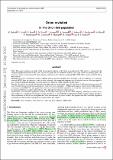Files in this item
Orion revisited : III. The Orion Belt population
Item metadata
| dc.contributor.author | Kubiak, K. | |
| dc.contributor.author | Alves, J. | |
| dc.contributor.author | Bouy, H. | |
| dc.contributor.author | Sarro, L. M. | |
| dc.contributor.author | Ascenso, J. | |
| dc.contributor.author | Burkert, A. | |
| dc.contributor.author | Forbrich, J. | |
| dc.contributor.author | Großschedl, J. | |
| dc.contributor.author | Hacar, A. | |
| dc.contributor.author | Hasenberger, B. | |
| dc.contributor.author | Lombardi, M. | |
| dc.contributor.author | Meingast, S. | |
| dc.contributor.author | Köhler, R. | |
| dc.contributor.author | Teixeira, P. S. | |
| dc.date.accessioned | 2017-12-12T16:30:16Z | |
| dc.date.available | 2017-12-12T16:30:16Z | |
| dc.date.issued | 2017-02-13 | |
| dc.identifier | 251732024 | |
| dc.identifier | e8eda416-0fe8-4748-982c-36ff4c17d90f | |
| dc.identifier | 85013113142 | |
| dc.identifier.citation | Kubiak , K , Alves , J , Bouy , H , Sarro , L M , Ascenso , J , Burkert , A , Forbrich , J , Großschedl , J , Hacar , A , Hasenberger , B , Lombardi , M , Meingast , S , Köhler , R & Teixeira , P S 2017 , ' Orion revisited : III. The Orion Belt population ' , Astronomy & Astrophysics , vol. 598 , A124 . https://doi.org/10.1051/0004-6361/201628920 | en |
| dc.identifier.issn | 0004-6361 | |
| dc.identifier.other | BibCode: 2017A&A...598A.124K | |
| dc.identifier.other | ORCID: /0000-0002-3665-5784/work/39714988 | |
| dc.identifier.uri | https://hdl.handle.net/10023/12319 | |
| dc.description | J. Alves acknowledges travel support from the ESAC Faculty council. H. Bouy is funded by the Ramón y Cajal fellowship program number RYC-2009-04497. | en |
| dc.description.abstract | Aims: This paper continues our study of the foreground population to the Orion molecular clouds. The goal is to characterize the foreground population north of NGC 1981 and to investigate the star formation history in the large Orion star-forming region. We focus on a region covering about 25 square degrees, centered on the ɛ Orion is supergiant (HD 37128, B0 Ia) and covering the Orion Belt asterism. Methods: We used a combination of optical (SDSS) and near-infrared (2MASS) data, informed by X-ray (XMM-Newton) and mid-infrared (WISE) data, to construct a suite of color-color and color-magnitude diagrams for all available sources. We then applied anew statistical multiband technique to isolate a previously unknown stellar population in this region. Results: We identify a rich and well-defined stellar population in the surveyed region that has about 2000 objects that are mostly M stars. We infer the age for this new population to be at least 5 Myr and likely 10 Myr and estimate a total of about 2500 members, assuming a normal IMF. This new population,which we call the Orion Belt population, is essentially extinction-free,disk-free, and its spatial distribution is roughly centered near ɛ Ori, although substructure is clearly present. Conclusions: The Orion Belt population is likely the low-mass counterpart to the Ori OB Ib subgroup. Although our results do not rule out Blaauw's sequential star formation scenario for Orion, we argue that the recently proposed blue streams scenario provides a better framework on which one can explain the Orion star formation region as a whole. We speculate that the Orion Belt population could represent the evolved counterpart of an Orion nebula-like cluster. | |
| dc.format.extent | 13 | |
| dc.format.extent | 9543863 | |
| dc.language.iso | eng | |
| dc.relation.ispartof | Astronomy & Astrophysics | en |
| dc.subject | Stars: formation | en |
| dc.subject | Stars: late-type | en |
| dc.subject | Stars: pre-main sequence | en |
| dc.subject | ISM: clouds | en |
| dc.subject | Globular clusters: general | en |
| dc.subject | QB Astronomy | en |
| dc.subject | 3rd-DAS | en |
| dc.subject.lcc | QB | en |
| dc.title | Orion revisited : III. The Orion Belt population | en |
| dc.type | Journal article | en |
| dc.contributor.institution | University of St Andrews. School of Physics and Astronomy | en |
| dc.identifier.doi | https://doi.org/10.1051/0004-6361/201628920 | |
| dc.description.status | Peer reviewed | en |
| dc.identifier.url | http://adsabs.harvard.edu/abs/2017A%26A...598A.124K | en |
| dc.identifier.url | https://arxiv.org/abs/1609.04948 | en |
This item appears in the following Collection(s)
Items in the St Andrews Research Repository are protected by copyright, with all rights reserved, unless otherwise indicated.

